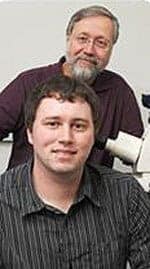Washington State University reproductive biologists have ruled out one of the leading thoughts on why older women have an increased risk of miscarriages and children with birth defects.
The 46-year-old “production-line hypothesis” says that the first eggs produced in a female’s fetal stage tend to have better connections or “crossovers” between chromosomes. The hypothesis asserts that as a woman ages and ovulates eggs produced later, these eggs will have more faulty chromosomes – leading to miscarriages and developmental abnormalities.
But after counting the actual chromosome crossovers in thousands of eggs, WSU researchers found those of eggs produced early in the fetal stage were no different from those produced later.
Abnormal cells early and late
“If the production-line hypothesis were true, you’d expect lots of abnormal cells and you would expect them all to be happening late,” said Ross Rowsey, a doctoral candidate in WSU’s Center for Reproductive Biology. “We do see a pretty high incidence of abnormal cells, but they’re just as likely to be happening early as late.”
Faulty chromosomes, in particular the incorrect number of chromosomes known as aneuploidy, account for more than one-third of human miscarriages and congenital birth defects, including Down syndrome. Their frequency rises dramatically in older women.
“The age of the woman is probably the most important risk factor associated with any human genetic disease,” said Terry Hassold, a WSU professor of reproductive biology and co-author with Rowsey and others of a paper on their findings in the American Journal of Human Genetics.
“It’s an extraordinary complication to human reproduction,” he said. “By the time a woman is in her 40s, it’s likely the majority of her eggs don’t have the right number of chromosomes. And if you don’t have the right number of chromosomes, you’ll either have a miscarriage or a congenital disability.”
Variations unrelated to age
The production-line hypothesis was put forth in 1968 by Alan Henderson and Robert Edwards, winner of the Nobel Prize for development of in-vitro fertilization. It has since become one of the most cited explanations for human aneuploidy.
To test the hypothesis, Rowsey looked at more than 8,000 eggs from 191 second-trimester fetal ovaries. The material came from elective abortions in accordance with the guidelines of the National Institutes of Health.
Rowsey treated eggs so proteins at chromosome crossovers would fluoresce, making dozens of glowing dots visible under a microscope. He then counted them and analyzed their distribution.
He saw a lot of variation within women and between women but no relationship to a woman’s age.
“There have to be other factors involved,” he said. “The abnormal crossovers can’t be explaining all of it.”
Resting proteins intriguing
Rowsey and Hassold said problems could be occurring at one, two or all of three stages: as the crossovers are formed, in the long rest stage before ovulation and/or as chromosomes divide during ovulation and fertilization.
Rowsey said he is particularly intrigued by the egg’s rest stage, when its proteins are called upon to remain intact for what can be decades.
“I don’t know a ton about protein stability,” he said, “but it seems to me like a single protein sitting there for 40 years is highly unlikely. But studies from model organisms show that those proteins aren’t replenished over time. I’m really interested to know what’s going on in that time.”


